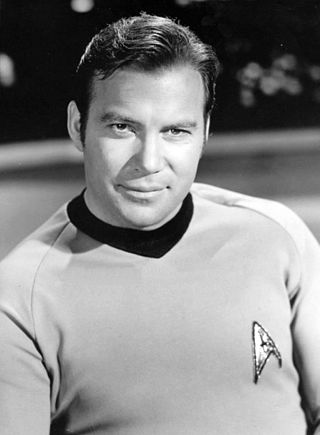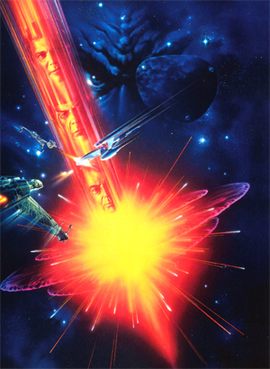Star Trek is an American science fiction television series created by Gene Roddenberry that follows the adventures of the starship USS Enterprise (NCC-1701) and its crew. It acquired the retronym of Star Trek: The Original Series to distinguish the show within the media franchise that it began.

Star Trek II: The Wrath of Khan is a 1982 American science fiction film directed by Nicholas Meyer and based on the television series Star Trek. It is the second film in the Star Trek film series following Star Trek: The Motion Picture (1979), and is a sequel to the television episode "Space Seed" (1967). The plot features Admiral James T. Kirk and the crew of the starship USS Enterprise facing off against the genetically engineered tyrant Khan Noonien Singh. When Khan escapes from a 15-year exile to exact revenge on Kirk, the crew of the Enterprise must stop him from acquiring a powerful terraforming device named Genesis. The film is the beginning of a three-film story arc that continues with the film Star Trek III: The Search for Spock (1984) and concludes with the film Star Trek IV: The Voyage Home (1986).

James Tiberius Kirk, commonly known as Captain Kirk, is a fictional character in the Star Trek media franchise. Originally played by Canadian actor William Shatner, Kirk first appeared in Star Trek serving aboard the starship USS Enterprise as captain. Kirk leads his crew as they explore new worlds and "boldly go where no man has gone before". Often, the characters of Spock and Leonard "Bones" McCoy act as his logical and emotional sounding boards, respectively. Kirk has also been portrayed in numerous films, books, comics, webisodes, and video games.

Leonard Simon Nimoy was an American actor and director, famed for playing Spock in the Star Trek franchise for almost 50 years. This includes originating Spock in the original Star Trek series in 1966, then Star Trek: The Animated Series, the first six Star Trek films, Star Trek: The Next Generation, the 2009 Star Trek film, and Star Trek Into Darkness. Nimoy also directed films, including Star Trek III: The Search for Spock (1984), Star Trek IV: The Voyage Home (1986), and Three Men and a Baby (1987), and his career included roles in music videos and video games. In addition to acting and filmmaking, Nimoy was a photographer, author, singer, and songwriter.

Spock is a fictional character in the Star Trek media franchise. He first appeared in the original Star Trek series serving aboard the starship USS Enterprise as science officer and first officer and later as commanding officer of the vessel. Spock's mixed human–Vulcan heritage serves as an important plot element in many of the character's appearances. Along with Captain James T. Kirk and Dr. Leonard "Bones" McCoy, he is one of the three central characters in the original Star Trek series and its films. After retiring from active duty in Starfleet, Spock served as a Federation ambassador, and later became involved in the ill-fated attempt to save Romulus from a supernova, leading him to live out the rest of his life in a parallel universe.

Star Trek: Phase II was the initial working title for what officially became titled Star Trek II, an unproduced American science fiction television series created by Gene Roddenberry as a sequel to the original Star Trek, which had run from 1966 to 1969. The plans for the series were first developed after several failed attempts to create a feature film based on the property, coupled with plans for a Paramount Television Service (PTS) as a fourth broadcast television network in the United States.

Star Trek IV: The Voyage Home is a 1986 American science fiction film, the fourth installment in the Star Trek film franchise based on the television series Star Trek. The second film directed by Leonard Nimoy, it completes the story arc begun in Star Trek II: The Wrath of Khan (1982), and continued in Star Trek III: The Search for Spock (1984). Intent on returning home to Earth to face consequences for their actions in the previous film, the crew of the USS Enterprise finds the planet in grave danger from an alien probe attempting to contact now-extinct humpback whales. The crew travel to Earth's past to find whales who can answer the probe's call.

Star Trek V: The Final Frontier is a 1989 American science fiction film directed by William Shatner and based on the television series Star Trek created by Gene Roddenberry. It is the fifth installment in the Star Trek film series, and takes place shortly after the events of Star Trek IV: The Voyage Home (1986). Its plot follows the crew of the USS Enterprise-A as they confront renegade Vulcan Sybok, who is searching for God at the center of the galaxy.

Star Trek VI: The Undiscovered Country is a 1991 American science fiction film directed by Nicholas Meyer, who also directed the second Star Trek film, The Wrath of Khan. It is the sixth feature film based on the 1966–1969 Star Trek television series. Taking place after the events of Star Trek V: The Final Frontier, it is the final film featuring the entire main cast of the original television series. The destruction of the Klingon moon Praxis leads the Klingon Empire to pursue peace with their longtime adversary, the Federation; the crew of the Federation starship USS Enterprise must race against unseen conspirators with a militaristic agenda.

Star Trek III: The Search for Spock is a 1984 American science fiction film, written and produced by Harve Bennett, directed by Leonard Nimoy, and based on the television series Star Trek. It is the third film in the Star Trek franchise and is the second part of a three-film story arc that begins with Star Trek II: The Wrath of Khan (1982) and concludes with Star Trek IV: The Voyage Home (1986). After the death of Spock (Nimoy), the crew of the USS Enterprise return to Earth. When James T. Kirk learns that Spock's spirit, or katra, is held in the mind of Dr. Leonard "Bones" McCoy, Kirk and company steal the decommissioned USS Enterprise to return Spock's body to his homeworld. The crew must also contend with hostile Klingons, led by Kruge, who are bent on stealing the secrets of the powerful terraforming device, Genesis.

Star Trek: The Motion Picture is a 1979 American science fiction film directed by Robert Wise. The Motion Picture is based on and stars the cast of the 1966–1969 television series Star Trek created by Gene Roddenberry, who serves as producer. In the film, set in the 2270s, a mysterious and powerful alien cloud known as V'Ger approaches Earth, destroying everything in its path. Admiral James T. Kirk assumes command of the recently refitted Starship Enterprise to lead it on a mission to determine V'Ger's origins and save the planet.

Nicholas Meyer is an American screenwriter, director and author known for his best-selling novel The Seven-Per-Cent Solution, and for directing the films Time After Time, two of the Star Trek feature films, the 1983 television film The Day After, and the 1999 HBO original film Vendetta.

Christine Chapel is a fictional character who appears in all three seasons of the American science fiction television series Star Trek: The Original Series, as well as Star Trek: The Animated Series and the films Star Trek: The Motion Picture and Star Trek IV: The Voyage Home. Portrayed by Majel Barrett, she was the ship's nurse on board the Starfleet starship USS Enterprise. A younger version of Chapel appears in the 2022 series Star Trek: Strange New Worlds, portrayed by Jess Bush.

Star Trek is a 2009 American science fiction action film directed by J. J. Abrams and written by Roberto Orci and Alex Kurtzman. It is the 11th film in the Star Trek franchise, and is also a reboot that features the main characters of the original Star Trek television series portrayed by a new cast, as the first in the rebooted film series. The film follows James T. Kirk and Spock aboard the USS Enterprise as they combat Nero, a Romulan from their future who threatens the United Federation of Planets. The story takes place in an alternate reality that features both an alternate birth location for James T. Kirk and further alterations in history stemming from the time travel of both Nero and the original series Spock. The alternate reality was created in an attempt to free the film and the franchise from established continuity constraints while simultaneously preserving original story elements.
"The Pirates of Orion" is the second season premiere episode of the American animated science fiction television series Star Trek: The Animated Series, the 17th episode overall. It first aired on September 7, 1974 on NBC. It was directed by Bill Reed and written by Howard Weinstein. The episode was Weinstein's first professional sale at the age of 19, making him, as of 2023, the youngest writer of any Star Trek TV episode.

Khan Noonien Singh is a fictional character in the Star Trek science fiction franchise who first appeared as the main antagonist in the Star Trek: The Original Series episode "Space Seed" (1967), and was portrayed by Ricardo Montalbán, who reprised his role in the 1982 film Star Trek II: The Wrath of Khan. In the 2013 film Star Trek Into Darkness, he is portrayed by Benedict Cumberbatch.
Star Trek: Planet of the Titans, also known as Star Trek: Planet of Titans, is an unproduced film based on Star Trek, which reached the script and design phases of pre-production. Following the success of Star Trek in broadcast syndication during the early 1970s and the popularity of the series at science-fiction conventions, Paramount Studios made several attempts to produce a feature film based upon the series. In 1975, Star Trek: The God Thing was proposed by franchise creator Gene Roddenberry but was not picked up by the studio.

The development of Spock, a fictional character first introduced in the American science fiction television series Star Trek, began prior to the start of the series. The first known mention of Spock was in a discussion between Gene Roddenberry and Gary Lockwood, where the latter suggested Leonard Nimoy for the role. Roddenberry agreed with the suggestion, and Nimoy became the first choice actor for the part. However, Roddenberry was required to audition other actors for the role. It was offered to both DeForest Kelley and Martin Landau before Nimoy. Nimoy disliked the prosthetic ears he was required to wear, and there were concerns from the studio that they made him appear satanic. Roddenberry fought to keep the character in the second pilot, "Where No Man Has Gone Before" after the rest of the main cast was dropped from the initial pilot, "The Cage".















